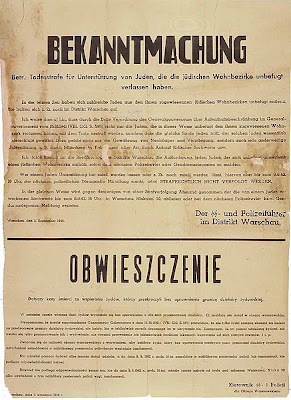Let me stress most emphatically that we who were rescuing
children are not some kind of heroes. Indeed, that term
irritates me greatly. The opposite is true. I continue to
have pangs of conscience that I did so little.
have pangs of conscience that I did so little.
 |
| Irena Sendler in 1942. |
Thanks to Steven Spielberg, most people have heard of Oskar Schindler. Few people have heard of Irene Sendler. Yet the Polish Catholic social worker helped save some 2,500 Jewish children during WWII.
 |
| Image courtesy of this site. |
She was born to a physician who died when she was seven from typhus contracted from his patients, many of them Jews that other physicians wouldn't treat. Jewish community leaders offered to pay for her education; she had close links to the Jewish community and even spoke Yiddish by the age of seven. In 1935, ghetto benches were introduced in Polish universities - segregated seating in a special section where Jewish students were forced to sit under threat of expulsion. Sendler was opposed to this and sat with her Jewish friends, and thus was almost expelled. A professor intervened, allowing her to continue with her studies.
 |
| Jewish children in the Warsaw Ghetto. |
This early testament to her ethical beliefs was a harbinger to her future endeavors. The Zegota, a codename for the Polish Council to Aid Jews, existed for the express purpose of helping Polish Jews get to safety. Poland was the only country in occupied Europe to have a dedicated secret organization. Prior to joining the Zegota, Sendler with a group of other like-minded people created over 3,000 false documents to help Jewish families. This was an extremely risky undertaking, as Poland had the most severe punishment of all occupied European nations for anyone harboring Jews. She was selected by the Zegota in 1943 to head the children's section. Since she was employed by the Social Welfare Department she had a special permit to enter the Warsaw Ghetto to check for signs of typhus. Under this pretext, she and others smuggled babies and small children in ambulances, packages, and even a toolbox. She also used an old courthouse and sewer pipes as routes to smuggle children out.
 |
| 1942 poster warning of death for any Pole who aided Jews. |
Sendler assured the children that they would be reunited with their relatives when the war was over. The group hid lists keeping track of everyone they rescued in jars buried in the ground. She worked with a Catholic orphanage in Warsaw, convents, and parishes to place the children. She was arrested in 1943 by the Gestapo, who tortured her and sentenced her to death. She bribed her guards who released her on her way to her execution, but was listed on a public bulletin as one of the executed. She lived in hiding until the end of the war, but continued aiding Jewish children. After the war she turned over her lists, but most of the families of the children had been exterminated or were missing.
 |
| Image courtesy of this site. |
During the Soviet takeover of Poland she was persecuted for being in contact with the Polish government in exile. She was not allowed to travel abroad by the Polish communist government to Israel to receive the Commander's Cross she was awarded by the Israeli Institute in 1964. She finally received it in 1984. She was also honored with the Righteous Among the Nations, a medal awarded by the State of Israel to non-Jews who saved Jews during the Holocaust. In 2003, fellow Pole and rescuer Pope John Paul II send her a personal letter of praise. That same year she was given the Order of the White Eagle, Poland's highest civilian honor. She received many other awards. She was nominated for the Nobel Peace Prize, but lost to Al Gore for his work on global warming.
 |
| Sendler in 2005. |
She died in 2008, known and honored by those who were aware of the efforts to save those threatened by the Holocaust, but little known to the world in general. She first came to public awareness in the year 2000, when a group of Kansas schoolgirls wrote a play about her called Life in a Jar. A documentary was made featuring her last interviews. It premiered earlier this year on PBs in honor of Holocaust Remembrance Day - Irena Sendler, In the Name of Their Mothers. But to those she saved, and their progeny, she will be loved and remembered always.
***************
Images, unless otherwise noted, courtesy of Wikipedia.
*******************************
No comments:
Post a Comment
NOTE: COMMENTS WITH LINKS WILL NOT BE POSTED!